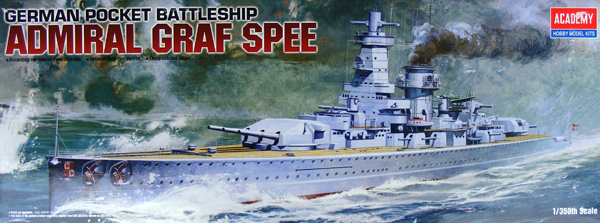
Academy 1/350 Graf Spee
By Tracy White
Overview
The Kit
In addition to the railings, the modeler may wish to fill in the recessed "boiler plate" texture on the fore-peak of the main deck and lower forward area of the superstructure as it is over-done and on the super structure at least is a detail that did not exist on the actual ship.
Test fitting and light construction have shown good fit. The only place that has needed filler between the two hull halves and four pieces that comprise the main deck, break, and after deck has been the joint between the main deck and the vertical bulkhead that makes the break. This piece is also a little soft on detail, showing only mild depressions where the windows in this section were. There has been no warping in either of the hull or deck parts.
Instructions
Decals
Building Experience
For the most part the Graf Spee is a fun kit to work on; well engineered and with few problems. The forward-most part of the superstructure is one exception to this. D19, the forward-most piece, and the two side pieces, D25 and D26 have an extremely vague joint; the instructions would have you join the three and then add the decks above, but I found it easier to join the two side pieces to the deck above and the the forward piece.
Inaccuracies and Omissions
There are a few things that are not represented correctly, and while they don't detract from the appearance of the model for most people, those suffering from Advanced Modelling Syndrome may wish to take notes.
There are a couple of problems with the stack; the mast on top is very over-simplified and incorrect; it was a tripod structure instead of the single cross-shaped pole and yard arm they provide. The kit stack also is perpendicular to the deck where it joins where in actuality there was a steep angled piece that is just visible in a couple of photographs.
The Graf Spee had two prop-guards on the stern that are missing from the model; they were poles or booms that swung out from the side of the ship and should be easy to scratch build; pictures of her stern at Monte Video show them to good affect.
Conclusion
Academy's Graf Spee is a decent kit for a decent price. In comparison to the Trumpeter kit, it suffers a bit in detail crispness and some detail, but has a more accurate hull shape and some details correct that Trumpeter got wrong.
